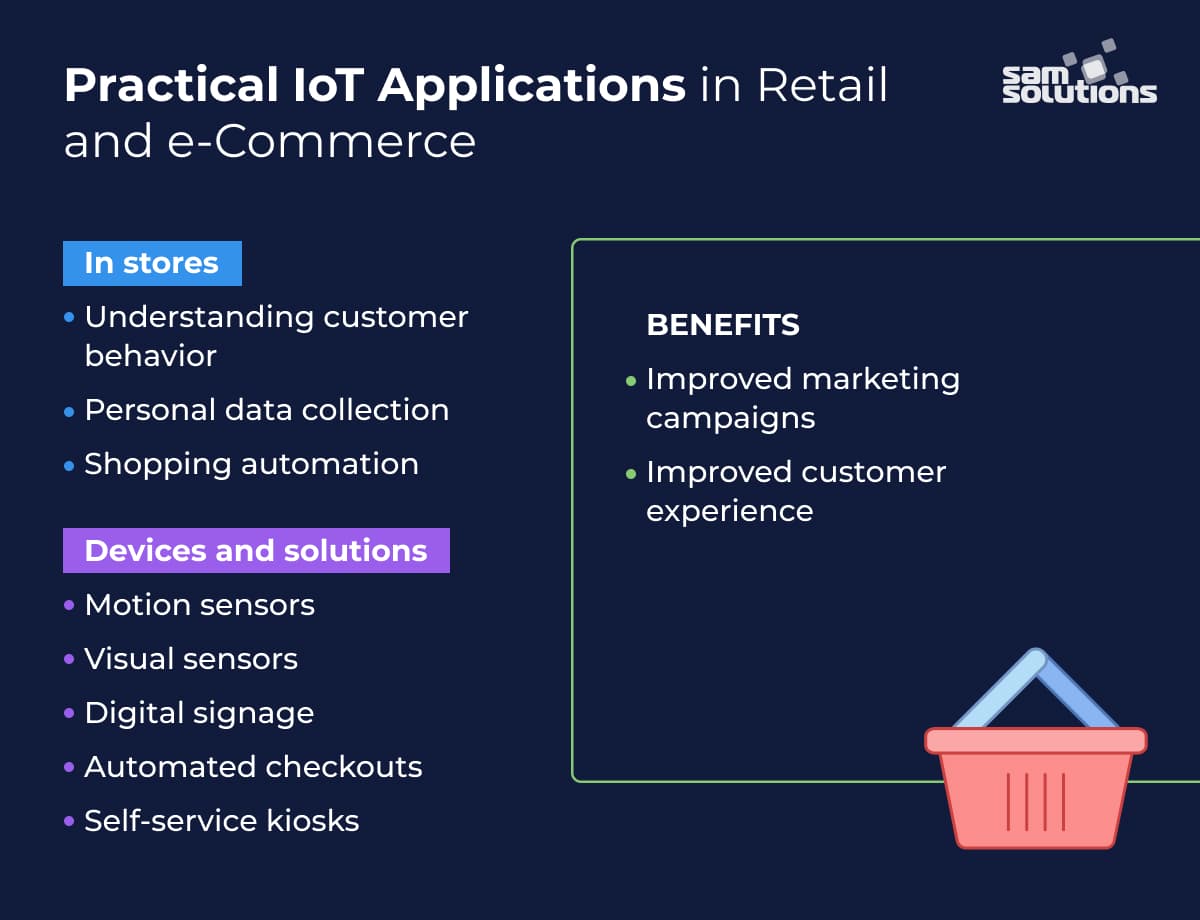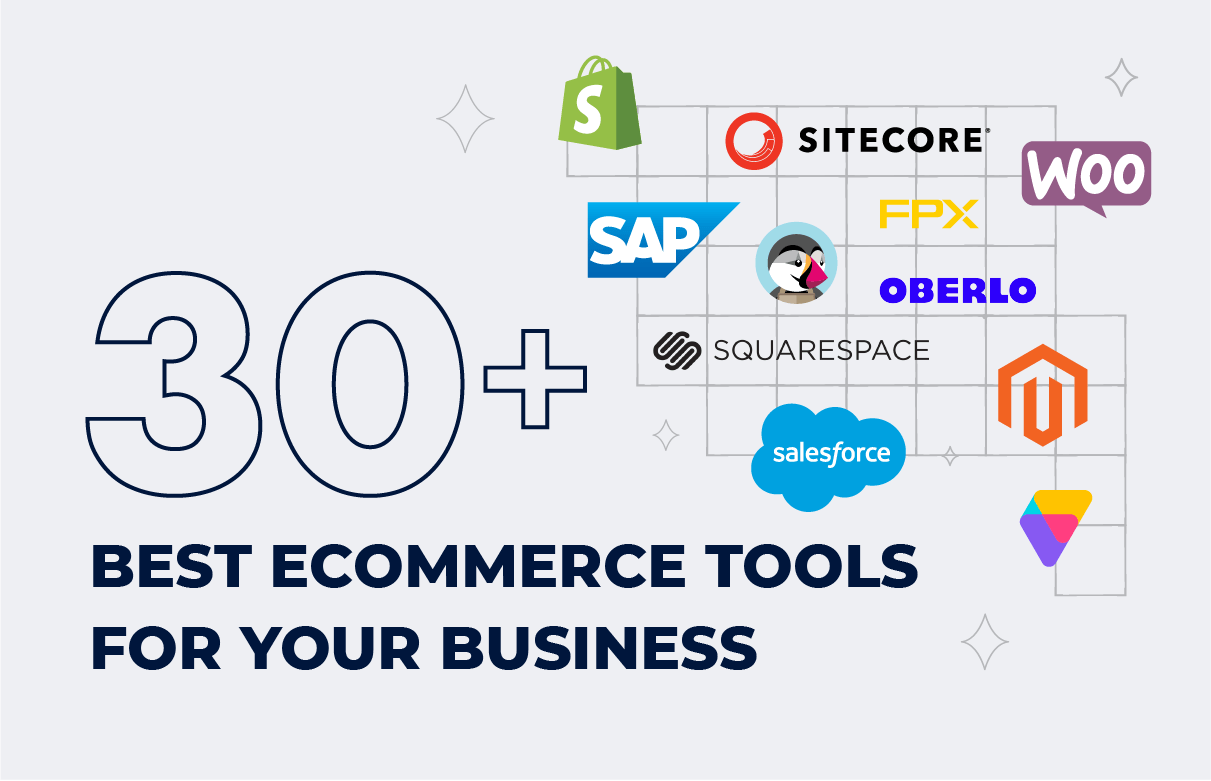The use of the Internet of Things in the retail industry is becoming mainstream due to the endless capabilities and improvements the technology offers to businesses in this sector. Internet of Things is a powerful tool that enables retailers to investigate customer behavior, create new business models and optimize productivity.
We’ve compiled a brief guide on the use cases of IoT in retail and eCommerce to demonstrate how connected devices can change trading for the better.
Transform your business or gain a competitive advantage in your industry with custom IoT software solutions from SaM Solutions.
How IoT Changes Commerce
The shift from on-site trading to the digital space has become evident over the past decade.
We’ve been witnessing the rapid emergence of eCommerce solutions in parallel with active digitization and automation of brick-and-mortar stores.
The two main reasons for such transformation are the development of intelligent technologies and growing consumer demand for more convenient and quick shopping.
On par with Machine Learning, Artificial Intelligence, blockchain and Big Data, the Internet of Things is the core technology influencing the reshaping of commerce.
Specialists from Grand View Research predict that global spending on IoT in retail will reach $94.44 billion by 2025, showing a 21.5% CAGR.
The diagram below by Statista depicts the most popular types of IoT hardware and the potential growth of their usage in the US retail industry.
Size of Internet of Things (IoT) hardware in the US retail market from 2014 to 2025 (in billion US dollars)

Source: Statista
As you can see, more and more retailers will use RFID tags and IoT sensors, while producers of innovative beacon technology will try to carve a niche in the market.
Practical IoT Applications in Retail and eCommerce
At first glance, one can hardly imagine how to implement IoT in retail stores or eCommerce processes other than for transport monitoring. However, there are numerous practical applications of connected devices integrated with other intelligent technologies in the commerce sector.
We can divide IoT use cases in retail into three categories depending on where these solutions are used: vehicles, warehouses, or stores.
1. IoT in Vehicles

All trading businesses are based on the transportation of goods; that’s why efficient logistics is the key to success.
More and more companies equip their freight vehicles with IoT-connected sensors, GPS trackers, or RFID (Radio Frequency Identification) tags to monitor their traveling in real time and access valuable data.
IoT devices ensure continuous tracking of goods moving from suppliers to warehouses or from warehouses to end users, providing a range of benefits.
Seamless supply chain management. The real-time control of goods transportation enables merchants to keep their stocks balanced and plan procurement effectively.
Intelligent logistics. Based on the online information about the location and speed of vehicles, and weather and traffic conditions, merchants can plan the most efficient routes to fulfill orders in time.
Prevention of spoilage, loss, or damage to goods. IoT sensors can control the conditions under which goods are being shipped (temperature, humidity, pressure, etc.) and alert drivers or managers if there are deviations from the norm. Thus, they support optimal conditions during the entire journey, allowing drivers to act to prevent goods from spoiling or damaging. This functionality is especially beneficial for food transportation.
Improved customer experience. Ecommerce customers also benefit from connected devices that collect information about their order status and send it to them via mobile apps or automated notifications. Thus, customers know what time the parcel will be at their doorstep and don’t need to worry about missing the delivery.
Self-driving delivery vehicles. While self-driving cars can’t travel the roads of cities on their own yet, slow-speed self-driving delivery vehicles are becoming a reality. Internet of Things technology is used to create devices that can replace couriers and deliver orders from eCommerce stores to customer residences. Thus, they ensure contactless delivery that is highly important in terms of pandemics.
2. IoT in Warehouses

It’s a challenging task to manage inventory in warehouses that store thousands of products and hundreds of product categories. IoT-connected sensors and devices automate numerous processes in such stocks and enable intelligent inventory management with minimal human participation.
Intelligent inventory management. IoT sensors and RFID tags installed in warehouses transform the way inventory is arranged.
- Devices automatically control items coming in and going out of the warehouse, categorizing them if/as needed (product type, color, size, expiration date).
- Sensors help automate the acceptance process and the allocation and movement of goods in a warehouse by indicating free spaces on the shelves.
- The availability of products in stock is updated in real time; sensors collect information and send it to the ERP system, which means that business owners can easily monitor quantities and customers can order only available items.
- IoT sensors monitor ambient conditions such as temperature for perishable products or vibration levels for fragile items and send instant alerts if needed, thus preventing their spoilage or damage.
- Smart shelves are a great innovation in IoT for the retail industry that aims to prevent shortage or overstock of products. Special sensors monitor the number of products on the stock shelves, analyze sales levels and place automatic orders when needed — all without human involvement.
Warehouse predictive maintenance. IoT applications in retail warehouses are not limited to the monitoring of products. Smart sensors can also control the state of equipment such as forklifts, ensuring predictive maintenance and reducing or eliminating downtime.
Warehouse robotization. The Internet of Things technology serves as a basis for robots that work alongside humans in warehouses. They can perform tasks such as picking, packing, transportation, stowing and more.
Benefits of IoT solutions in warehouses:
- Continuous inventory control
- Reduced human errors
- Improved efficiency of the inventory management
- Reduced costs
- Accurate analysis
- Customer satisfaction
3. IoT in Stores

Many brick-and-mortar stores are developing their digital transformation strategies to keep pace with the competition. Besides introducing retail software solutions in their processes, they can also benefit from retail IoT solutions.
Understanding customer behavior. Personal customer data, as well as data on customer behavior in stores, is priceless, so retailers should know how to collect and use such information.
IoT-enabled motion sensors installed in shopping carts or baskets determine customer movements around a store, such as:
- which aisles they go along and which ones they skip;
- what shelves they stop near and how long they look at the products for;
- whether they pay attention to particular offers or not.
All sensors transmit information via Bluetooth or other IoT connectivity options to the centralized cloud system for analysis.
In this way, marketing specialists can identify store sections with the highest and lowest traffic. Based on this data, they can create more efficient merchandising strategies and optimize the physical layout of the store.
Personal data collection. Many shops and public places feature digital advertising screens called digital signage. The crucial function of these IoT solutions, besides promoting products or services, is to capture customer data.
How does it work? Well, digital screens incorporate a variety of motion sensors and AI-based technologies such as computer vision that can identify numerous characteristics of the audience standing in front of the screen.
The parameters that digital signage can perceive include:
- gender, age, body constitution
- gestures
- emotions
- view time.
Digital marketers with insight into such customer-centric data can significantly improve their marketing strategies and create more appealing offers for their customers.
Automation of shopping processes. IoT in supermarkets is also represented by automated checkouts and interactive kiosks that enable customers to process their purchases without cashier assistance.
The technology goes even further, as demonstrated by Amazon’s new “grab and go” concept. In the Amazon Go chain of supermarkets, there are no lines and no checkouts. People take goods and the payment is processed automatically with the help of sensors, cameras, and smart weighing devices that integrate with smartphones.
Beneficial Merging of Retail and IoT
The installation of IoT sensors in the retail transport fleet and the adoption of connected solutions in stores and warehouses help retailers gain a competitive advantage.
The benefits are visibility and flexibility of all processes, data-based decision making, improved services and happier customers.
Specialists at SaM Solutions have extensive experience developing both Internet of Things solutions and eCommerce and retail projects. If you want to integrate these technologies and create a valuable smart retail IoT solution, fill in the contact form to get a consultation.



















 The Latest 15 Information Technology Trends in 2024
The Latest 15 Information Technology Trends in 2024 Top 10 Embedded Software Development Tools
Top 10 Embedded Software Development Tools IaaS vs. PaaS vs. SaaS: What’s the Difference?
IaaS vs. PaaS vs. SaaS: What’s the Difference? IoT Development: Top 15 Internet of Things Tools and Platforms in 2024
IoT Development: Top 15 Internet of Things Tools and Platforms in 2024 10 Examples of Predictive Analytics
10 Examples of Predictive Analytics










![What Is Ecommerce Customer Service? [Including 8 Best Practices]](https://www.sam-solutions.com/blog/wp-content/uploads/Customer-Service-in-eCommerce.png)

 What Is Headless CMS?
What Is Headless CMS? SAP Commerce Cloud vs Shopify: A Detailed Comparison for Businesses
SAP Commerce Cloud vs Shopify: A Detailed Comparison for Businesses Java and Cloud Development: An Ideal Pairing
Java and Cloud Development: An Ideal Pairing Component-Based Architecture in Software Engineering: A Comprehensive Guide
Component-Based Architecture in Software Engineering: A Comprehensive Guide Micro Frontend: What It Is and How It Works
Micro Frontend: What It Is and How It Works